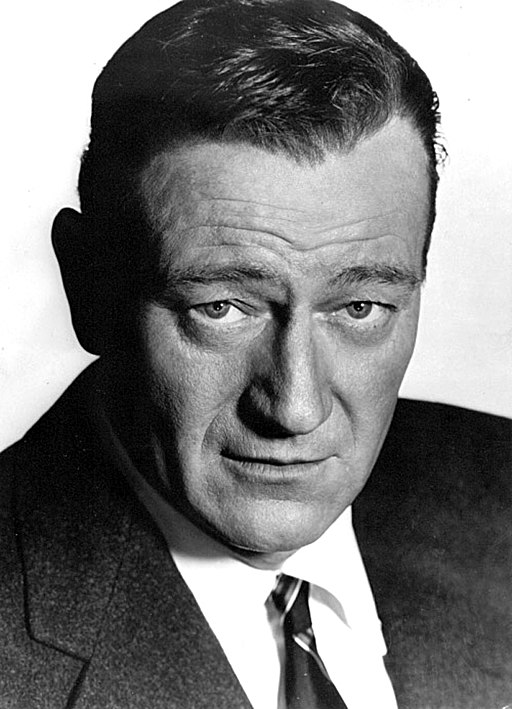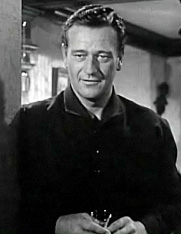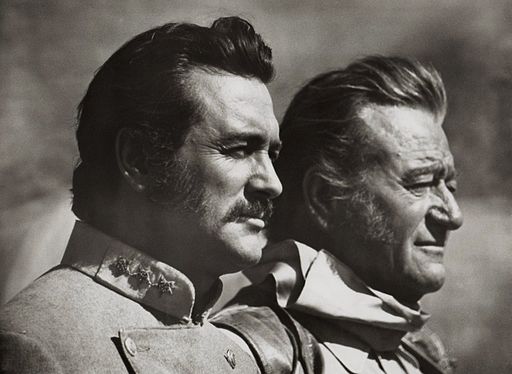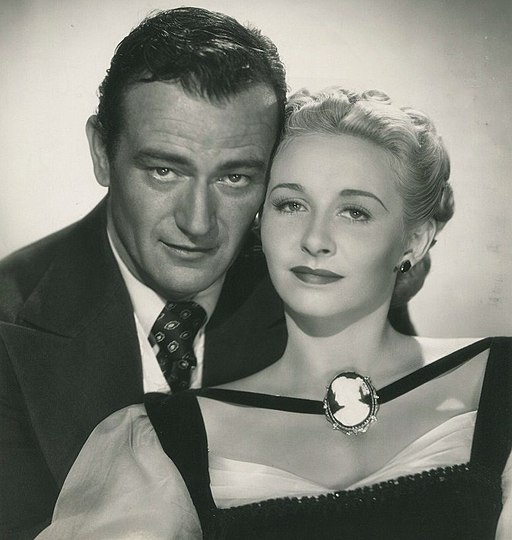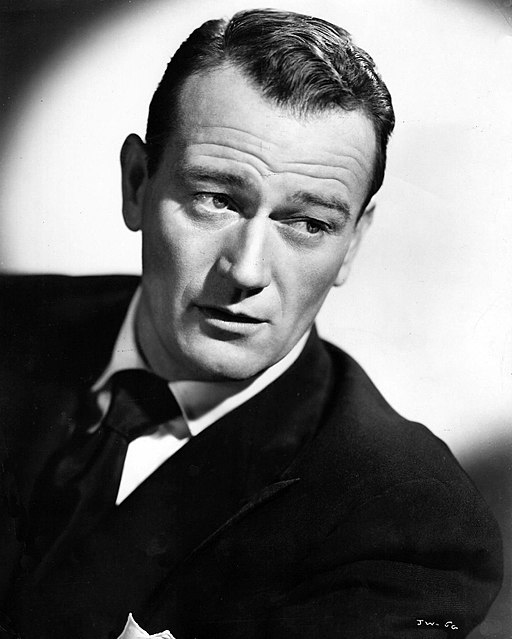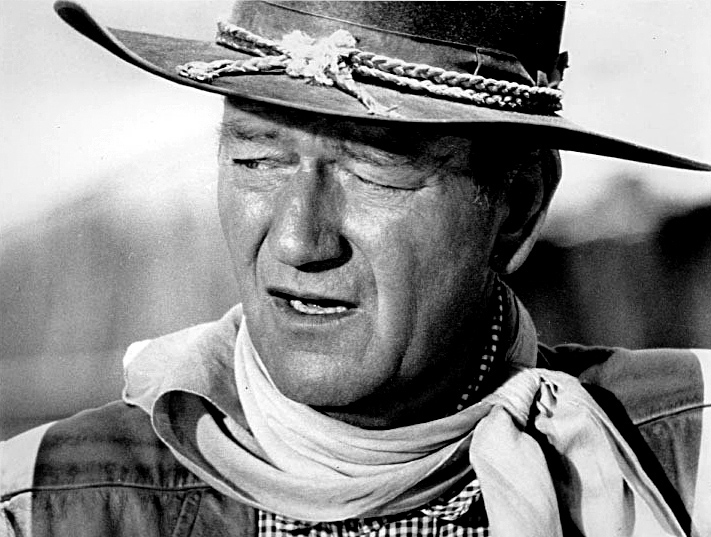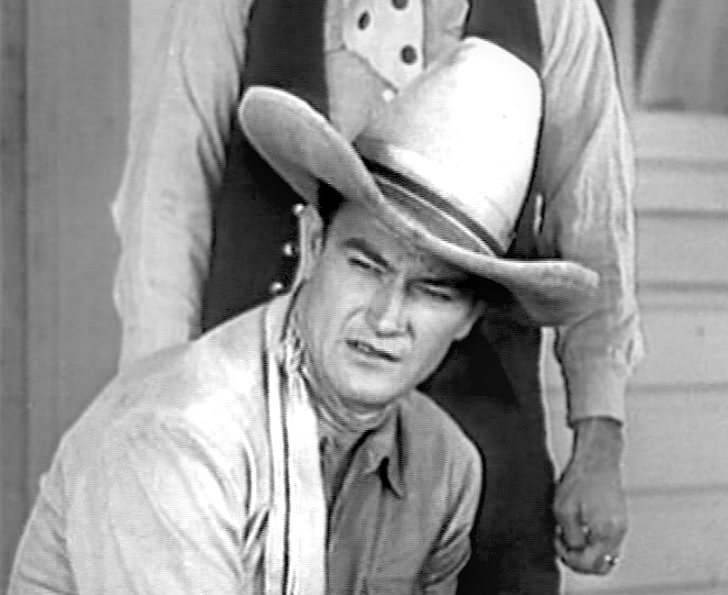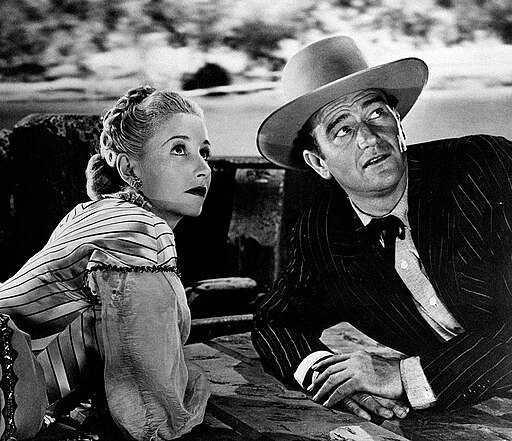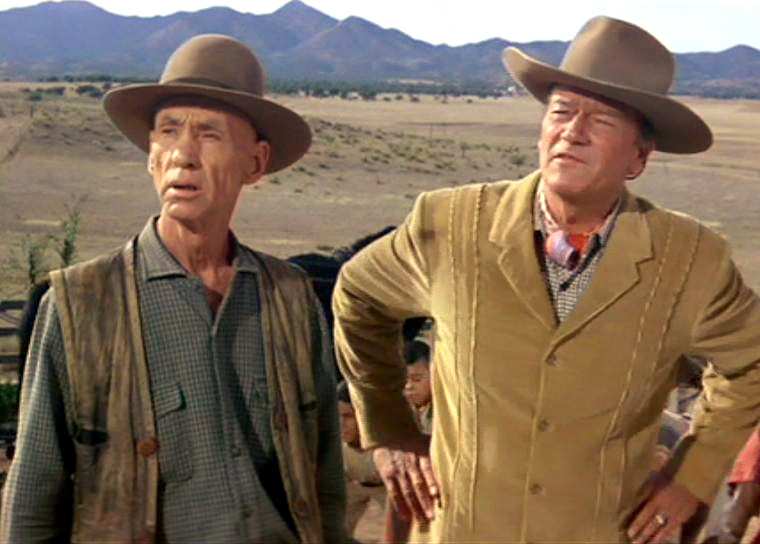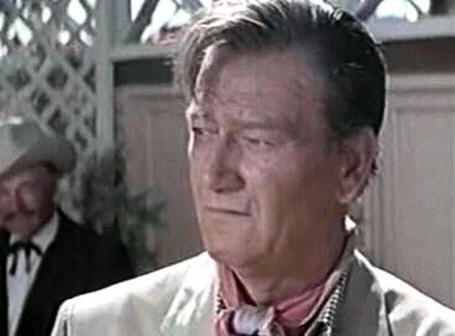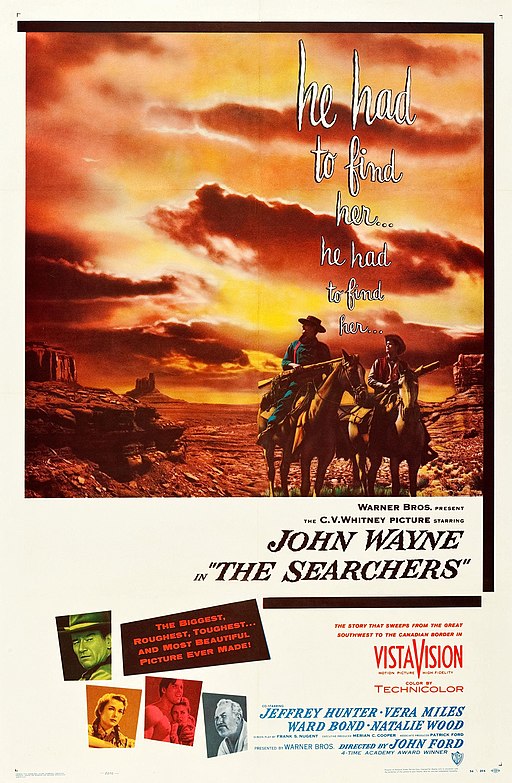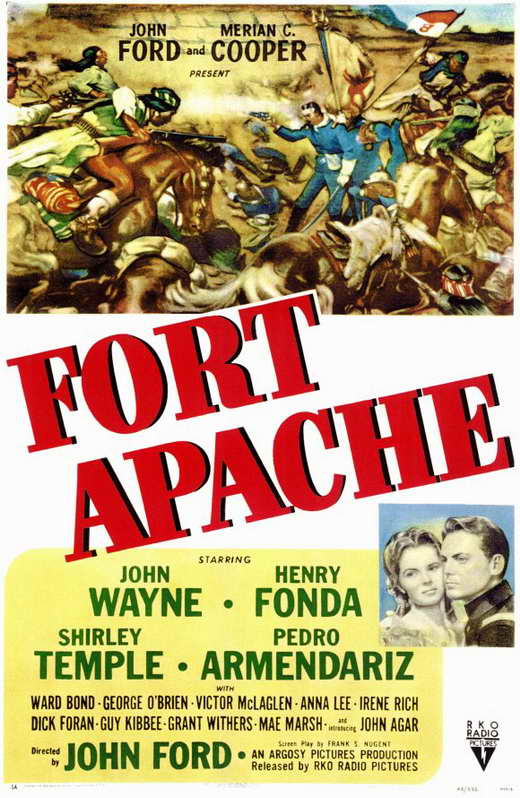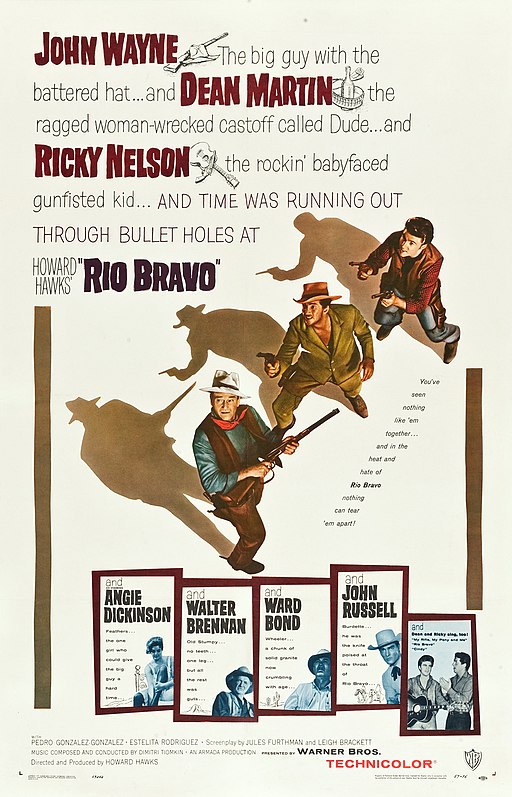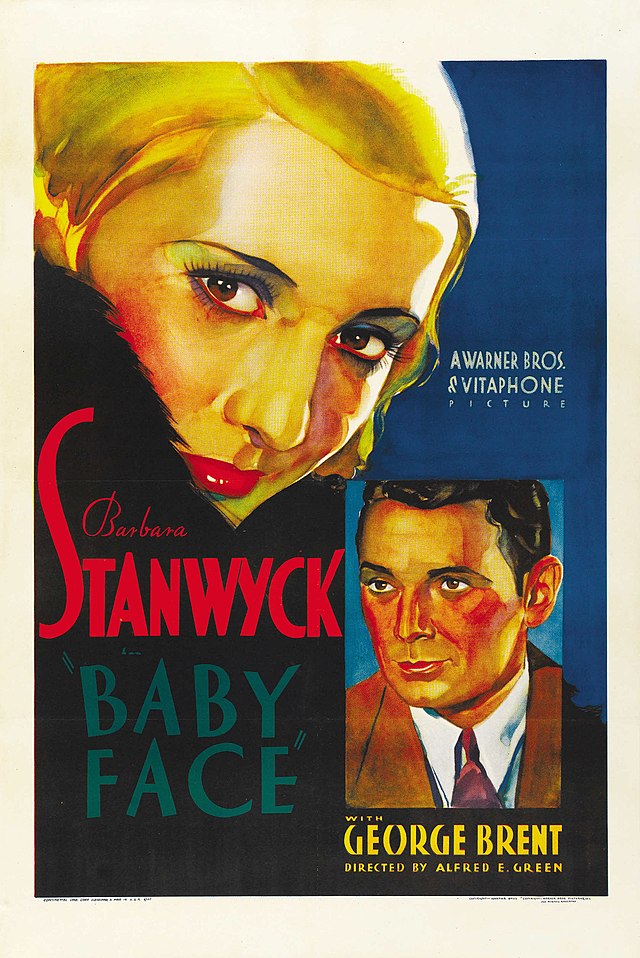John Wayne
back| Full Name | Marion Robert Morrison (later changed to Marion Mitchell Morrison) |
| Stage Name | John Wayne |
| Born | May 26, 1907 |
| Birthplace | Winterset, Iowa, USA |
| Died | June 11, 1979 |
| Buried | Pacific View Memorial Park, Corona del Mar, Newport Beach, California, USA |
| Married to | Josephine Alicia Saenz (1933-1945) - Esperanza Baur (1946-1954) - Pilar Pallete (1954-1979, his death) |
| Children | Michael Wayne (from his marriage to Josephine) - Mary Antonia |
| Notable films | Stagecoach (1939) - Red River (1948) - Fort Apache (1948) - The Searchers (1956) - Rio Bravo (1959) - The Man Who Shot Liberty Vallance (1962) - True Grit (1969) |
John Wayne
“The Duke” of Hollywood
John Wayne, born Marion Robert Morrison, is an iconic figure in American film, particularly known for his roles in Westerns and war movies.
His on-screen persona as a rugged, no-nonsense hero made him a symbol of American masculinity and a cultural icon. Wayne's career spanned four decades, during which he appeared in over 140 films.
He was also noted for his conservative political views, which were both admired and criticized. His legacy as an actor and his impact on American culture remain significant to this day.
Related
John Wayne – Biography and Analysis of his Career
Born: May 26, 1907, in Winterset, Iowa, John Wayne was originally named Marion Robert Morrison. His parents were Clyde Leonard Morrison, a pharmacist, and Mary "Molly" Alberta Brown. The family moved to Southern California when Wayne was young.
John Wayne was famously nicknamed "The Duke," a moniker that originated in his childhood and stayed with him throughout his life and career. This nickname was reportedly derived from his dog, an Airedale Terrier named "Duke." Young Marion Morrison (John Wayne's real name) was so inseparable from his pet that local firefighters in Glendale, California, started calling him "Little Duke." Eventually, the "Little" was dropped, and he was simply known as "Duke."
Wayne's path towards stardom began with humble beginnings. He attended Glendale High School in California, where he excelled in both academics and sports. His football talents earned him a scholarship to the University of Southern California (USC), but an injury and the loss of his scholarship led to a drastic change in his life's direction.
Wayne's film career started in the 1920s when he worked at local film studios to pay for his tuition. His imposing stature and rugged good looks caught the attention of directors, leading to bit parts in films. His big break came in 1930 with "The Big Trail," but it was the 1939 movie "Stagecoach" that made him a star. This film marked the beginning of a successful partnership with director John Ford, with whom he made some of his most memorable films.
Personal Life: Marriages and Children
Wayne was married three times. His first wife was Josephine Alicia Saenz, with whom he had four children: Michael, Toni, Patrick, and Melinda. After their divorce, he married Esperanza Baur, a Mexican actress, but the marriage was troubled and ended in divorce. His third wife was Pilar Palette, with whom he had three more children: Aissa, John Ethan, and Marisa.
Passions and Interests
Besides acting, Wayne had a deep passion for America and its ideals, which was often reflected in his films and public statements. He was an ardent anti-communist and a staunch conservative, often involved in political debates of his time. Wayne also loved the sea and spent a significant amount of time aboard his yacht, the Wild Goose.
Career Highlights
Wayne's filmography is extensive, with over 140 movies to his credit. He is best known for his roles in Westerns and war movies. Some of his most famous films include "The Searchers," "True Grit," for which he won an Academy Award, and "The Man Who Shot Liberty Valance." His on-screen persona as a tough, moralistic, and quintessentially American character made him an enduring icon.
Death and Legacy
John Wayne died on June 11, 1979, at the age of 72, from stomach cancer. He had battled cancer since the 1960s and was a vocal advocate for cancer research. Wayne passed away at the UCLA Medical Center and was buried in the Pacific View Memorial Park in Corona del Mar, California.
His death marked the end of an era in Hollywood. Wayne symbolized a rugged, individualistic America and was revered by many as an embodiment of the nation's spirit and values. His influence on the Western genre and American cinema as a whole is indelible. Even decades after his passing, John Wayne remains a significant figure in the cultural landscape of the United States.
Oscar Ceremony 1970: John Wayne wins Academy Award for Best Actor:
John Wayne’s Best Movies:
1930s
- The Big Trail (1930): An early epic Western where Wayne plays a young frontiersman leading settlers across the Oregon Trail.
- Stagecoach (1939): A breakthrough role for Wayne as the Ringo Kid, an outlaw who joins a group of varied passengers on a dangerous journey through Apache territory.
1940s
- Fort Apache (1948): In this classic Western directed by John Ford, Wayne portrays Captain Kirby York, a disciplined cavalry officer clashing with his new commander.
- Red River (1948): Wayne plays Tom Dunson, a tyrannical cattle rancher on a perilous cattle drive, facing mutiny from his adopted son.
1950s
- Rio Grande (1950): Wayne reunites with director John Ford, playing Lt. Col. Kirby Yorke, dealing with Apache raids and his estranged son's arrival at his post.
- The Quiet Man (1952): A departure from Westerns, Wayne stars as Sean Thornton, an American boxer returning to his ancestral home in Ireland, seeking peace and love.
- The Searchers (1956): In this iconic Western, Wayne plays Ethan Edwards, a man on an obsessive quest to rescue his niece from Native American captivity.
1960s
- The Man Who Shot Liberty Valance (1962): Wayne is Tom Doniphon, a tough rancher involved in the making of a Western legend in a town terrorized by a bandit.
- True Grit (1969): In his Academy Award-winning role, Wayne plays Rooster Cogburn, a drunken, hard-nosed U.S. Marshal who helps a young girl track down her father's murderer.
1970s
- The Cowboys (1972): Wayne portrays Wil Andersen, a rancher who must hire schoolboys to help him on a 400-mile cattle drive.
- The Shootist (1976): In his final film, Wayne plays J.B. Books, an aging gunslinger dying of cancer who seeks a dignified end.
Analysis of the Acting Style of John Wayne:
John Wayne's acting style is a study in the art of screen presence and the embodiment of a particular brand of American masculinity. His approach to acting was less about transformation and more about projecting a consistent, recognizable persona that resonated deeply with audiences. Here’s a detailed analysis:
- Subtle and Understated: Wayne's style was marked by a naturalism that often eschewed overt dramatics. He was not an actor of intense method acting or wide emotional range but rather conveyed his characters through a more subdued and understated approach.
- Authenticity: He brought an authenticity to his roles, often playing characters that aligned with his own personality and values. This made his performances appear seamless and genuine, as if he wasn't acting at all but simply being himself on screen.
- Imposing Physicality: At 6'4", Wayne had a commanding presence. His physicality was a key component of his acting style. He used his height and build to dominate the screen, often portraying strong, rugged characters.
- Distinctive Walk and Posture: His distinctive walk – a rolling gait that was both confident and relaxed – became a hallmark of his characters. This physicality lent an air of casual authority to his roles.
- Deep, Resonant Voice: Wayne's deep, resonant voice was a significant part of his screen identity. He spoke with a slow, deliberate drawl that emphasized his words and often conveyed more with less.
- Expressiveness Through Dialogue: He had a knack for delivering lines in a way that made even simple dialogue memorable. His way of speaking added depth to his characters, suggesting a world-weariness or experienced wisdom.
- The Rugged Individualist: Wayne often played characters that epitomized the rugged individualist, a common archetype in American folklore. These characters were typically stoic, morally upright, and self-reliant.
- Symbol of American Values: His roles often reflected traditional American values such as bravery, honesty, and integrity. He became synonymous with a certain idealized version of American masculinity and heroism.
- Subdued Emotionality: Wayne's characters were typically not emotionally effusive. He portrayed emotion in a restrained manner, often through subtle expressions, gestures, or changes in tone rather than overt displays.
- Internalized Performances: His acting style suggested an internalization of emotions, conveying depth and complexity beneath a rugged exterior. This stoicism was a key aspect of his appeal, particularly in Western and war films.
- Consistent Screen Persona: Over his career, Wayne maintained a consistent screen persona. This consistency made him extremely reliable and relatable to his audience.
- Everyman Hero: Despite often playing larger-than-life characters, there was an everyman quality to his roles. Audiences could relate to his portrayals of heroism, moral conviction, and resilience.
- Iconic Status: Wayne's style helped him achieve an iconic status in Hollywood. He wasn't just an actor but a symbol of an era and a set of ideals.
- Influence on Genre and Cinema: His acting had a significant impact on the Western genre, shaping its conventions and its portrayal of the American frontier hero.
Memorable Quotes from John Wayne:
Quotes from Movies:
From "True Grit" (1969): "Well, come see a fat old man sometime!" - This line is from Wayne's Oscar-winning role as Rooster Cogburn, a tough, one-eyed U.S. Marshal.
From "The Shootist" (1976): "I won't be wronged. I won't be insulted. I won't be laid a-hand on. I don’t do these things to other people, and I require the same from them." - One of his last films, this line encapsulates the personal code of the aging gunslinger he portrays.
From "She Wore a Yellow Ribbon" (1949): "Never apologize, mister, it's a sign of weakness." - As Captain Nathan Brittles, Wayne delivers this line, reflecting the tough, stoic nature of his character.
From "The Searchers" (1956): "That'll be the day." - This simple, yet impactful line delivered by Wayne's character Ethan Edwards became one of his most famous quotes.
From "El Dorado" (1966): "I'm a dying man, scared of the dark." - In this film, Wayne plays Cole Thornton, a gunfighter, and this line poignantly reflects his character’s vulnerability.
From "Big Jake" (1971): "I thought you were dead." - "Not hardly." - This exchange occurs several times in the film, exemplifying Wayne's often understated sense of humor.
From "McLintock!" (1963): "You have to be a man first before you're a gentleman. He works at it, you know, ma'am, every day." - Playing George Washington McLintock, Wayne delivers this line about the nature of being a gentleman.
From "Rio Bravo" (1959): "Sorry don't get it done, Dude." - As Sheriff John T. Chance, Wayne's character often delivered lines that were both tough and reflective of his practical outlook.
From "The Quiet Man" (1952): "There'll be no locks or bolts between us, Mary Kate... except those in your own mercenary little heart!" - This line reflects the romantic and spirited nature of his character, Sean Thornton, in this non-Western role.
From "Stagecoach" (1939): "Well, I guess there's nothing to do now but tell the folks back home and pay the bill." - As the Ringo Kid, this was one of the lines that helped establish Wayne as a major star.
Personal Quotes:
On Courage and Fear: "Courage is being scared to death… and saddling up anyway." - This quote reflects Wayne's view on facing fears and challenges head-on.
On Success: "Tomorrow is the most important thing in life. Comes into us at midnight very clean. It's perfect when it arrives and it puts itself in our hands. It hopes we’ve learned something from yesterday."
On Responsibility: "A man's got to have a code, a creed to live by, no matter his job."
On Life's Hardships: "Life is tough, but it's tougher if you're stupid."
On Taking Action: "Talk low, talk slow, and don't say too much."
On American Values: "I am an old-fashioned, honest-to-goodness, flag-waving patriot."
On Acting: "I've always followed my father's advice: he told me, first to always keep my word and, second, to never insult anybody unintentionally. If I insult you, you can be goddamn sure I intend to. And, third, he told me not to go around looking for trouble."
On Making a Difference: "I would like to be remembered, well... the Mexicans have a phrase, 'Feo fuerte y formal'. Which means he was ugly, strong and had dignity."
On America: "Sure I wave the American flag. Do you know a better flag to wave?"
On Self-Reflection: "I've played the kind of man I'd like to have been."
John Wayne's Best Lines:
John Wayne Hats:
John Wayne's hats, especially in his Western films, were as iconic as the actor himself, contributing significantly to his on-screen persona. Here's an overview of the hats he wore and their significance:
The Cowboy Hat
- Signature Look: In most of his Westerns, John Wayne wore a cowboy hat, which became synonymous with his image. The style of these hats varied slightly from film to film, but they generally had a few consistent characteristics.
- High Crown and Wide Brim: The hats usually featured a high crown and a wide brim. The brim was often shaped or bent in a distinctive way, giving each hat a unique look that matched the character he was portraying.
- Variations for Character: The way the hat was worn and its condition often reflected the character's personality and circumstances. For example, a well-worn hat might symbolize a rugged, experienced outdoorsman.
Specific Hats for Characters
- "The Searchers" (1956): In this film, Wayne wore a modified cavalry hat, which was a Civil War-era military hat. This hat had a lower crown and a brim that was pinned up on one side, giving it a distinctive look that set his character, Ethan Edwards, apart from typical Western heroes.
- "True Grit" (1969): In "True Grit," Wayne wore a worn, sweat-stained hat, which helped define his character, Rooster Cogburn, as a grizzled, no-nonsense U.S. Marshal. The hat added to the gritty realism of the character.
- "Rio Bravo" (1959), "El Dorado" (1966), "Rio Lobo" (1970): In these films, Wayne's character typically wore a hat with a taller crown and a less shaped brim, which complemented his portrayal as a lawman.
Symbolism
- Icon of the American West: The cowboy hat is a powerful symbol of the American West, and John Wayne's use of this hat helped cement this iconography in popular culture.
- Masculinity and Heroism: The hat contributed to the overall image of masculinity, rugged individualism, and heroism that Wayne's characters often embodied.
Off-Screen Influence
- Fashion and Popular Culture: Wayne's hats influenced fashion trends and popular perceptions of the quintessential American cowboy look. Even today, his style of hat is often associated with the archetypal Western hero.
Quality and Craftsmanship
- Custom Made: Many of Wayne's hats were custom-made by skilled hat makers. The quality and craftsmanship ensured that the hats were not only visually appealing but also functional and durable, suitable for the rigors of on-location shooting.
John Wayne Statues:
The John Wayne statue is a tribute to the iconic American actor, symbolizing his significant contribution to the film industry and American culture. There are several statues of John Wayne, but the most notable ones are located in California and Iowa.
John Wayne Statue at John Wayne Airport, California
- Location: One of the most famous statues of John Wayne is located at John Wayne Airport in Orange County, California. This airport was named in his honor.
- Unveiling: The statue was unveiled in 1982, a few years after Wayne's death in 1979.
- Description: The statue portrays Wayne in a typical Western pose, dressed in cowboy attire, complete with a cowboy hat, bandana, and a gun belt. It captures his iconic persona as a Western hero.
- Material and Size: It is a bronze statue, standing at about 9 feet tall.
- Significance: The statue serves as a homage to Wayne, who lived and worked in Orange County and was a prominent figure in the community.
John Wayne Statue in Winterset, Iowa
- Location: Another notable statue of John Wayne is in Winterset, Iowa, his birthplace.
- Unveiling: This statue was also unveiled posthumously.
- Description: Similar to the one in California, it depicts Wayne as a cowboy, a role that he famously portrayed in many of his films.
- Material and Size: It is also made of bronze.
- Significance: The statue is part of the larger John Wayne Birthplace Museum and Learning Center, which includes a museum dedicated to Wayne's life and career.
Other Statues and Memorials
- Additional Locations: There are other statues and memorials dedicated to John Wayne in various locations across the United States, each celebrating different aspects of his life and career.
- Cultural Impact: These statues are not just commemorations of Wayne as an individual but also serve as symbols of the cultural impact he had as an actor. They honor his legacy as a quintessential figure in American cinema, especially in the Western genre.
These statues of John Wayne continue to be points of interest for fans and tourists, reflecting the enduring popularity and cultural significance of "The Duke." They are testaments to his lasting influence as a symbol of American values and the rugged individualism represented in his films.
Trivia:
A] Shoe Size:
John Wayne, known for his towering stature and commanding presence, reportedly had a shoe size of 11B (US size). His shoe size is often noted in the context of his large physical build, which contributed significantly to his on-screen presence and iconic status in Hollywood, particularly in Western and action films.
B] How Tall was John Wayne?
John Wayne was approximately 6 feet 4 inches (193 cm) tall. His height, along with his distinctive voice and demeanor, contributed significantly to his commanding screen presence.
C] Movies in which John Wayne died:
- "The Cowboys" (1972): Wayne plays Wil Andersen, a rancher who hires schoolboys for a cattle drive. His character is killed by the film's antagonist.
- "The Alamo" (1960): In this historical epic, Wayne portrays Davy Crockett, who dies fighting at the Battle of the Alamo.
- "The Shootist" (1976): One of Wayne's most poignant roles, he plays J.B. Books, an aging gunfighter dying of cancer. The character is killed in a shootout at the end of the film.
- "Sands of Iwo Jima" (1949): Wayne plays Sergeant John M. Stryker, a tough Marine Corps sergeant who is killed in action during World War II.
- "Wake of the Red Witch" (1948): Wayne's character, Captain Ralls, dies while diving in a sunken ship, marking a rare occurrence of his character dying in a non-Western film.
- "Reap the Wild Wind" (1942): Wayne portrays Captain Jack Stuart, who drowns after a fight with the antagonist, played by Raymond Massey.
- "The Fighting Seabees" (1944): He plays Wedge Donovan, who dies during a battle in the film.
- "The Sea Chase" (1955): Wayne's character, Captain Karl Ehrlich, goes down with his ship.
- "Jet Pilot" (1957): His character, Colonel Jim Shannon, is implied to have died after the film ends.
Awards & Recognition:
Academy Awards
- 1969: Won the Academy Award for Best Actor for his role in "True Grit." This was a significant recognition, as it was the only Oscar he won in his career.
- 1949: Received a nomination for Best Actor for his performance in "Sands of Iwo Jima."
Golden Globe Awards
- 1970: Won the Golden Globe for Best Actor – Motion Picture Drama for "True Grit."
- 1953: Received a nomination for World Film Favorite – Male.
- 1964: Received a Henrietta Award for World Film Favorite – Male.
Other Honors
- 1979: Awarded the Congressional Gold Medal posthumously. This is one of the highest civilian honors in the United States, recognizing Wayne's impact on American culture.
- 1980: Awarded the Presidential Medal of Freedom posthumously by President Jimmy Carter, the highest civilian award of the United States.
- 1966: Received the DeMolay Legion of Honor. DeMolay International is a youth organization, and Wayne was a member in his youth.
- 1953: Awarded the Photoplay Award for Most Popular Male Star.
- 1974: Inducted into the Hall of Great Western Performers of the National Cowboy & Western Heritage Museum.
Special Screenings and Tributes
- 1979 (Posthumously): A special tribute at the Academy Awards ceremony honoring his career in the film industry.
- Various: Numerous retrospectives and tributes at film festivals and by film organizations, celebrating his impact on the Western genre and American cinema.
Star on the Hollywood Walk of Fame
- 1960: Received a star on the Hollywood Walk of Fame, located at 1541 Vine Street, for his contributions to the motion picture industry.
Full List of Movies featuring John Wayne:
1920s
- Brown of Harvard (1926)
- Bardelys the Magnificent (1926)
- The Great K & A Train Robbery (1926)
- Annie Laurie (1927)
- The Drop Kick (1927)
- Mother Machree (1928)
- Four Sons (1928)
- Hangman's House (1928)
- Speakeasy (1929)
- The Black Watch (1929)
- Noah's Ark (1929)
1930s
- Men Without Women (1930)
- Born Reckless (1930)
- Rough Romance (1930)
- Cheer Up and Smile (1930)
- The Big Trail (1930)
- Girls Demand Excitement (1931)
- Three Girls Lost (1931)
- Arizona (1931)
- The Deceiver (1931)
- Range Feud (1931)
- Maker of Men (1931)
- The Shadow of the Eagle (1932)
- Texas Cyclone (1932)
- Two-Fisted Law (1932)
- Lady and Gent (1932)
- The Hurricane Express (1932)
- Ride Him, Cowboy (1932)
- That's My Boy (1932)
- The Big Stampede (1932)
- Haunted Gold (1932)
- The Telegraph Trail (1933)
- The Three Musketeers (1933)
- Central Airport (1933)
- Somewhere in Sonora (1933)
- His Private Secretary (1933)
- The Life of Jimmy Dolan (1933)
- Baby Face (1933)
- The Man from Monterey (1933)
- Riders of Destiny (1933)
- College Coach (1933)
- Sagebrush Trail (1933)
- The Lucky Texan (1934)
- West of the Divide (1934)
- Blue Steel (1934)
- The Man from Utah (1934)
- Randy Rides Alone (1934)
- The Star Packer (1934)
- The Trail Beyond (1934)
- The Lawless Frontier (1934)
- 'Neath the Arizona Skies (1934)
- Texas Terror (1935)
- Rainbow Valley (1935)
- The Desert Trail (1935)
- The Dawn Rider (1935)
- Paradise Canyon (1935)
- Westward Ho (1935)
- The New Frontier (1935)
- Lawless Range (1935)
- The Oregon Trail (1936)
- The Lawless Nineties (1936)
- King of the Pecos (1936)
- The Lonely Trail (1936)
- Winds of the Wasteland (1936)
- Sea Spoilers (1936)
- Conflict (1936)
- California Straight Ahead! (1937)
- I Cover the War (1937)
- Idol of the Crowds (1937)
- Adventure's End (1937)
- Born to the West (1937)
- Pals of the Saddle (1938)
- Overland Stage Raiders (1938)
- Santa Fe Stampede (1938)
- Red River Range (1938)
- Stagecoach (1939)
- The Night Riders (1939)
- Three Texas Steers (1939)
- Wyoming Outlaw (1939)
- New Frontier (1939)
- Allegheny Uprising (1939)
1940s
- The Dark Command (1940)
- Three Faces West (1940)
- The Long Voyage Home (1940)
- Seven Sinners (1940)
- A Man Betrayed (1941)
- Lady from Louisiana (1941)
- The Shepherd of the Hills (1941)
- Lady for a Night (1942)
- Reap the Wild Wind (1942)
- The Spoilers (1942)
- In Old California (1942)
- Flying Tigers (1942)
- Pittsburgh (1942)
- Reunion in France (1942)
- A Lady Takes a Chance (1943)
- In Old Oklahoma (1943)
- The Fighting Seabees (1944)
- Tall in the Saddle (1944)
- Flame of Barbary Coast (1945)
- Back to Bataan (1945)
- They Were Expendable (1945)
- Dakota (1945)
- Without Reservations (1946)
- Angel and the Badman (1947)
- Red River (1948)
- Fort Apache (1948)
- 3 Godfathers (1948)
- Wake of the Red Witch (1948)
- The Fighting Kentuckian (1949)
- Sands of Iwo Jima (1949)
- She Wore a Yellow Ribbon (1949)
1950s
- Rio Grande (1950)
- Operation Pacific (1951)
- Flying Leathernecks (1951)
- The Quiet Man (1952)
- Big Jim McLain (1952)
- Trouble Along the Way (1953)
- Island in the Sky (1953)
- Hondo (1953)
- The High and the Mighty (1954)
- The Sea Chase (1955)
- Blood Alley (1955)
- The Conqueror (1956)
- The Searchers (1956)
- Jet Pilot (1957)
- The Wings of Eagles (1957)
- Legend of the Lost (1957)
- I Married a Woman (1958)
- The Barbarian and the Geisha (1958)
- Rio Bravo (1959)
1960s
- The Alamo (1960)
- North to Alaska (1960)
- The Comancheros (1961)
- The Man Who Shot Liberty Valance (1962)
- Hatari! (1962)
- The Longest Day (1962)
- How the West Was Won (1962)
- Donovan's Reef (1963)
- McLintock! (1963)
- Circus World (1964)
- The Greatest Story Ever Told (1965)
- In Harm's Way (1965)
- The Sons of Katie Elder (1965)
- Cast a Giant Shadow (1966)
- El Dorado (1966)
- The War Wagon (1967)
- The Green Berets (1968)
- Hellfighters (1968)
- True Grit (1969)
1970s
- Chisum (1970)
- Rio Lobo (1970)
- Big Jake (1971)
- The Cowboys (1972)
- The Train Robbers (1973)
- Cahill U.S. Marshal (1973)
- McQ (1974)
- Brannigan (1975)
- Rooster Cogburn (1975)
- The Shootist (1976)

